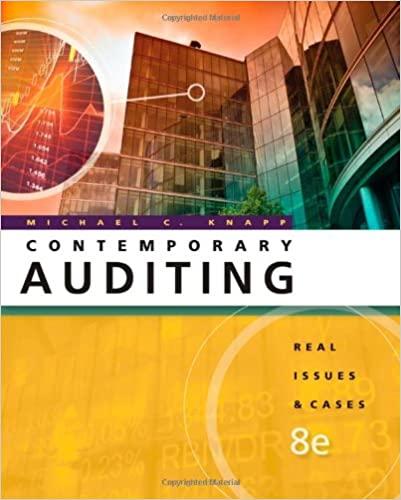During the 1970s, the public accounting profession eliminated its bans on competitive bidding, advertising, direct solicitation, and
Question:
During the 1970s, the public accounting profession eliminated its bans on competitive bidding, advertising, direct solicitation, and related practices that the Federal Trade Commission maintained were restraints of trade. The decision to drop those restrictions contributed to the increasingly competitive nature of the market for independent audits over the following decades. That escalating competition was manifested by a rapid increase in the rate of auditor changes by public companies, “lowballing” on the part of certain accounting firms to obtain new clients, and stagnant or declining audit fees. By the late 1990s, many leading accountants suggested that the independent audit “product” was diminishing in value. The American Institute of Certified Public Accountants (AICPA) concurred with that point of view in an article that appeared in its monthly newsletter. To counter the declining value of independent audits, the AICPA recommended that accounting firms begin developing and marketing other services.
The audit—the CPA profession’s core assurance product—has been declining in value over the past few years, becoming a less marketable product. In fact, revenues from traditional accounting and auditing services have been fl at for the past seven years . . . Where challenges exist, however, opportunities abound. . . [nontraditional] assurance services provide a lucrative opportunity to expand [accounting] practices. CPAs are singularly qualified as independent assurance providers to furnish businesses and their customers with the certainty they need to compete in today’s marketplace.1 To identify new professional services that accountants could begin providing the AICPA created the Assurance Services Special Committee that was chaired by Robert Elliott, a senior audit partner with KPMG. Elliott’s committee recommended a wide range of new services that accounting practitioners could market. Specific examples of such services included the following: ascertaining the quality of home healthcare providers and assisted living (nursing home) facilities, identifying security breaches of Internet-linked information systems, and helping companies and other organizations identify and manage the economic risks they faced. The AICPA believed that these and other nontraditional services would provide accounting firms an opportunity to significantly increase their revenues while at the same time enhancing their overall stature and reputation within the business community.
Among the boldest initiatives taken by the AICPA in the late 1990s to expand the product line of services offered by CPAs was a proposal to create a new professional designation for accountants. This new credential would be awarded to individuals who passed a rigorous examination to demonstrate that they qualified as “multidisciplinary business advisers and strategic thinkers.”2 The AICPA believed this new professional designation would help existing CPAs strengthen their credibility as general business consultants and thereby allow them to gain a larger share of the rapidly expanding market for business consulting services worldwide. Throughout the 1990s and into the new century, the major international accounting firms began offering an extended product line of nontraditional services. These firms invested heavily in advertising programs and other promotional activities to market these new services. However, as these firms attempted to develop new markets and encroach on existing markets served by other professionals they encountered unexpected challenges and problems.
Nontraditional professional services marketed by the major accounting firms during the 1990s included “environmental and labor practices audits.” These engagements were not financial statement audits but rather examinations intended to determine whether a given company, organization, or specific production facility was complying with state and federal laws, industry rules and regulations, and other predetermined criteria relevant to environmental issues and labor practices. The accounting profession’s dominant firms recognized that there was a growing demand for environmental and labor practices audits and similar engagements during the 1990s. This demand sprang from a social activism movement during the latter part of the twentieth century that targeted high profile companies in the United States that allegedly operated, or purchased goods from, “sweatshops” in foreign countries.
Ernst & Young and PricewaterhouseCoopers (PwC) were the most prolific providers of environmental and labor practices audits within the accounting profession. In 1998 alone, PwC performed 1,500 such audits in China’s Guangdong province, that nation’s industrial epicenter.3 Wikipedia defines a sweatshop as a “working environment with very difficult or dangerous conditions, usually where the workers have few rights or ways to address the situation.” These conditions may include “exposure to harmful materials, hazardous situations, extreme temperatures, or abuse from employers.” Social activists claimed that many large U.S. companies were maximizing their profits by using sweatshops in third-world countries to minimize the production cost of the merchandise they sold. In 1996, Wal-Mart was blindsided by a firestorm of unfavorable media attention ignited by a social activist organization. This organization revealed that Wal-Mart’s popular line of Kathie Lee Gifford apparel was being manufactured under sweatshop conditions in the Central American nation of Honduras. Over the following several years, many other U.S. companies would face similar charges. The company targeted more than any other by the anti-sweatshop activists was Nike, Inc., the world’s largest producer of athletic shoes..........
Questions
1. Define each of the following types of professional services: consulting services, attestation services, agreed-upon procedures engagements, and assurance services. Explain how, if at all, these services overlap.
2. Visit the websites of the major international accounting fi rms. Identify nontraditional services currently marketed by these fi rms. List several of these services and briefly describe their nature. Of the services you identified, are there any that you believe accounting firms should not provide? If so, explain.
3. On what types of engagements must CPAs be “independent”? Identify types of engagements on which CPAs are not required to be independent. What other traits should CPAs possess on professional services engagements?
Step by Step Answer:

Contemporary Auditing Real Issues And Cases
ISBN: 9780538466790
8th Edition
Authors: Michael C. Knapp





